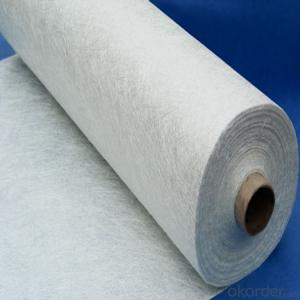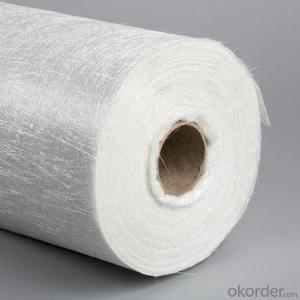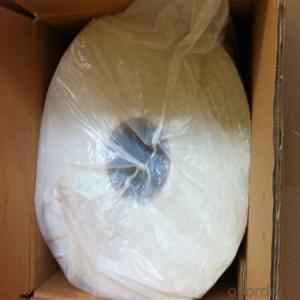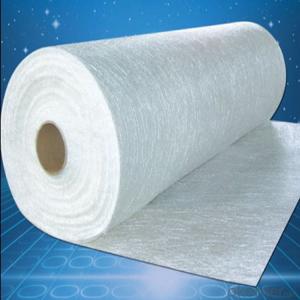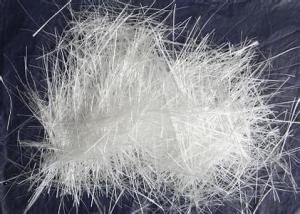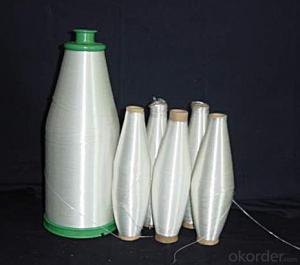300 g/m2 FiberGlass Chopped Strand Mat
- Loading Port:
- China main port
- Payment Terms:
- TT OR LC
- Min Order Qty:
- 1 kg
- Supply Capability:
- 5000 kg/month
OKorder Service Pledge
OKorder Financial Service
You Might Also Like
Product Description:
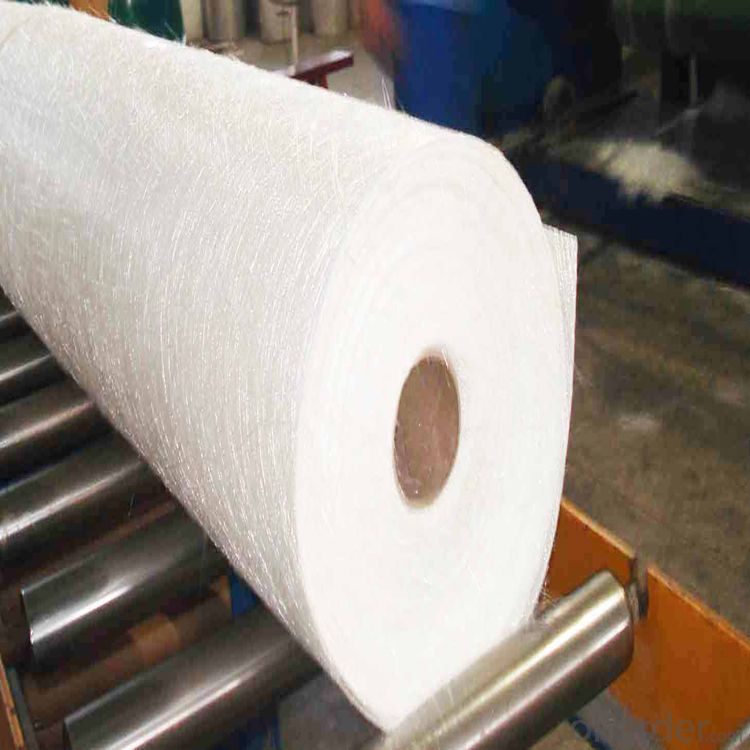
Surfacing Tissue mainly used in the surface layers of FRP products. It features even Fiber distribution, soft feel, level and smooth fiber surface, less glue content, quick resin soak and good pattern fitness. It can improve the product surface property on corrosion resistance, compressive strength, seepage resistance, and longer service life. It is also suitable for spraying; pattern pressing and other FRP pattern technology.
Surfacing Tissue mainly used in the surface layers of FRP products. It features even Fiber distribution, soft feel, level and smooth fiber surface, less glue content, quick resin soak and good pattern fitness. It can improve the product surface property on corrosion resistance, compressive strength, seepage resistance, and longer service life. It is also suitable for spraying; pattern pressing and other FRP pattern technology.
Product Features:
Fast breakdown in styrene
Fiber dispersed evenly
Low binder content
Superior acid corrosion resistance
Specifications:
Item | Over Density | Moisture Content | Chop Density | Polyester Yarn | Width |
(g/m2) | (%) | (g/m2) | (g/m2) | (mm) | |
EMK300 | 309.5 | ≤0.15 | 300 | 9.5 | 50-3300 |
EMK380 | 399 | 380 | 19 | ||
EMK450 | 459.5 | 450 | 9.5 | ||
EMK450 | 469 | 450 | 19 | ||
EMC0020 | 620.9 | 601.9 | 19 | ||
EMC0030 | 909.5 | 900 | 9.5 |
Product Packaging:
Each Surface Tissue is wound onto a paper tube which has an inside diameter of 76mm and the mat roll has a diameter of 330mm. The mat roll is wrapped up with plastic film,and then packed in a cardboard box or wrapped up with kraft paper. The rolls can be vertically or horizontally placed. For transportation, the rolls can be loaded into a cantainer directly or on pallets.
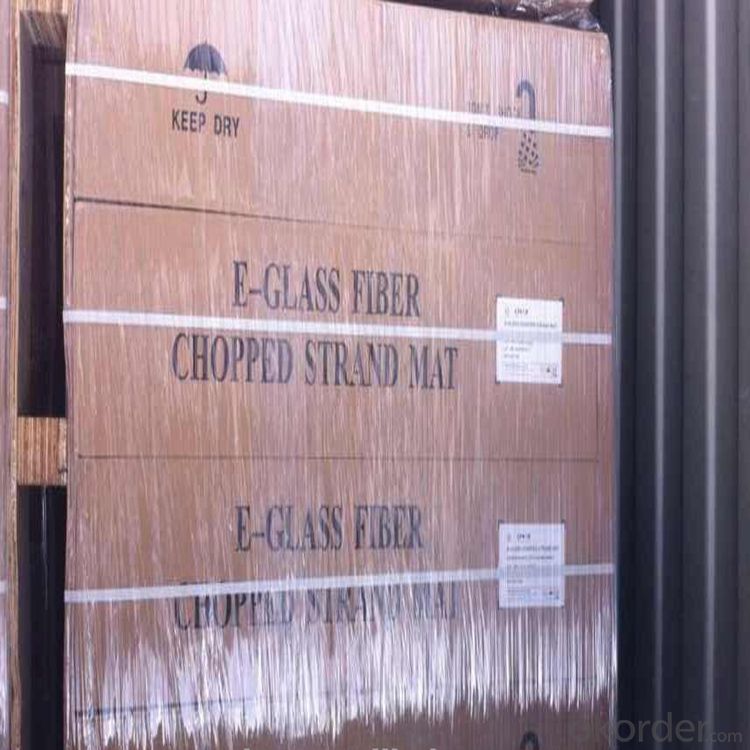
Product Storage:
Unless otherwise specified, Chopped Strand Mat should be stored in a dry, cool and rain-proof area. It is recommended that the room temperature and humidity should be always maintained at 15℃~35℃ and 50%~75% respectively.
Company Information
CNBM (China National Building Material) Group is the largest comprehensive building materials group in China that in integrate scientific research, manufacturing and logistics into one entity. The largest building materials and equipment specialists in China. Upon State Council approval, today CNBM owned more than 300 subordinate manufacturing factories and servicing companies. There are 6 fully owned public listed companies and 11 partially owned with substantial shares public listed companies. In many of these fields, CNBM is playing the leading role in the building industry in the country.

- Q:Is fiberglass chopped strand suitable for the production of roofing materials?
- Yes, fiberglass chopped strand is suitable for the production of roofing materials. It offers excellent strength, durability, and resistance to weather conditions, making it an ideal choice for roofing applications. Additionally, its lightweight nature allows for easy installation and reduces the overall weight of the roof.
- Q:What is the cost of fiberglass chopped strand compared to other materials?
- The cost of fiberglass chopped strand compared to other materials can vary depending on several factors such as the quality, quantity, and supplier. However, in general, fiberglass chopped strand is considered to be a relatively cost-effective material compared to other alternatives. Compared to materials like carbon fiber or aramid (Kevlar), fiberglass chopped strand is typically more affordable. This is because the production process of fiberglass is less complex and less costly. Additionally, fiberglass chopped strand is widely available and has a large market share, which helps keep the prices competitive. In comparison to traditional materials like steel or aluminum, fiberglass chopped strand can also offer cost advantages. Fiberglass is generally lighter in weight, which can reduce transportation and installation costs. It is also corrosion-resistant, eliminating the need for additional coatings or treatments to prevent rust or degradation. Furthermore, fiberglass chopped strand offers excellent strength-to-weight ratios, making it a cost-effective choice for applications where high strength and durability are required. It is important to note that while fiberglass chopped strand may have a relatively lower upfront cost compared to some materials, the overall cost-effectiveness depends on the specific application, performance requirements, and long-term maintenance considerations. Conducting a thorough cost analysis and considering factors beyond the initial purchase price is essential in determining the true cost of using fiberglass chopped strand compared to other materials.
- Q:Two-way stretch plastic geogrid
- High-intensity Geonet, Geotextile, Uniaxial Plastic Geogrid, Steel-plastic composite Geogrid, Composite geomembrane, and two double to the grid line, Maree Modoo axial loom, Fiberglass geogrid, Polyester geogrid, Geonet, two one-way grille production line, Dornier loom.
- Q:What do glass fiber operating tools do?
- Drawing, drying, winding, fabric etc.
- Q:Is fiberglass chopped strand suitable for structural applications?
- Yes, fiberglass chopped strand is suitable for structural applications. Chopped strand is made of short glass fibers that are randomly oriented and held together with a binder. It is commonly used as a reinforcement material in combination with resin to create composite materials, such as fiberglass reinforced plastics (FRP). These FRP composites offer high strength-to-weight ratios, excellent corrosion resistance, and good dimensional stability. When used in structural applications, fiberglass chopped strand can provide added strength and durability. It is often used in the construction industry for applications such as beams, columns, panels, and bridges. The random orientation of the fibers allows for multidirectional reinforcement, enhancing the overall strength of the structure. Additionally, fiberglass chopped strand has good impact resistance and can withstand heavy loads, making it suitable for structural applications where strength and reliability are crucial. However, it is important to note that the specific properties and performance of fiberglass chopped strand may vary depending on factors such as the fiber length, diameter, and composition, as well as the resin system used. Proper engineering and design considerations are necessary to ensure that the chosen fiberglass chopped strand is appropriate for the specific structural application.
- Q:Does fiberglass chopped strand improve the impact resistance of composite materials?
- Yes, fiberglass chopped strand does improve the impact resistance of composite materials. Chopped strand is made up of small, randomly oriented fibers that are mixed into the composite material during the manufacturing process. These fibers provide reinforcement and enhance the overall strength and durability of the composite. When an impact occurs, the fiberglass chopped strand helps to distribute the force and absorb the energy, preventing it from concentrating in one area and causing damage. The fibers act as a barrier, absorbing and dispersing the impact energy throughout the composite material, thereby reducing the likelihood of cracks or fractures. Furthermore, fiberglass chopped strand enhances the interfacial bonding between the fibers and the matrix of the composite, improving the load transfer capability. This increased bonding strength contributes to the overall impact resistance of the composite material. In summary, the addition of fiberglass chopped strand to composite materials significantly improves their impact resistance by dispersing and absorbing impact energy, preventing localized damage, and enhancing the overall strength and durability of the composite.
- Q:How does the surface treatment of fiberglass chopped strand affect its adhesion to resin?
- The adhesion of resin to fiberglass chopped strand is significantly affected by the surface treatment. During the manufacturing process, fiberglass chopped strand is typically treated with a sizing agent to improve its compatibility with resin systems. The purpose of this surface treatment is to establish a chemical bond between the chopped strand and the resin matrix. By creating a thin layer on the surface of the fiberglass strands, the sizing agent acts as a bridge between the hydrophilic glass fibers and the hydrophobic resin. This layer enhances the wetting and adhesion properties of the fiberglass, promoting better bonding with the resin. The choice of sizing agent depends on the specific resin system being utilized. Different types of sizing agents can be employed to optimize adhesion with polyester, epoxy, or vinyl ester resins. Moreover, the sizing agent can be customized to offer additional advantages, such as improved impact resistance, UV stability, or heat resistance. If the fiberglass chopped strand is not adequately surface treated, the adhesion between the strands and the resin may be compromised. Inadequate wetting of the fibers by the resin can result in weak interfacial bonding, leading to delamination or reduced mechanical properties in the final composite product. In summary, the surface treatment of fiberglass chopped strand plays a vital role in enhancing its adhesion to resin. It enhances the wetting and bonding properties, ensuring the creation of a robust and long-lasting composite material.
- Q:Is fiberglass chopped strand resistant to mold and mildew?
- Yes, fiberglass chopped strand is generally resistant to mold and mildew. The inherent properties of fiberglass, such as its non-porous nature and resistance to moisture, make it a less favorable environment for the growth of mold and mildew. However, it's important to note that while fiberglass itself may be resistant to mold and mildew, other factors such as moisture accumulation and improper installation can still contribute to the growth of mold and mildew in the surrounding areas.
- Q:How is fiberglass chopped strand used in the consumer goods industry?
- Due to its versatile properties and numerous applications, fiberglass chopped strand is widely utilized in the consumer goods industry. Its primary use is in enhancing the strength, durability, and overall performance of various consumer goods. One way fiberglass chopped strand is commonly employed in the consumer goods industry is in the production of plastic products. By incorporating chopped strands into the plastic matrix, the final product's strength and rigidity are significantly improved. This is especially beneficial for items like automotive parts, electrical enclosures, and furniture components that need to withstand heavy loads or external impacts. Moreover, fiberglass chopped strand is utilized in the manufacturing of appliances such as refrigerators, washing machines, and ovens. These appliances often require heat resistance and insulation properties, which can be achieved by including chopped strands in their construction. The fiberglass reinforcement provides enhanced thermal stability, enabling the appliances to endure high temperatures without deformation or structural damage. Another important application of fiberglass chopped strand in the consumer goods industry is in the production of sporting goods and recreational equipment. It is commonly used in items like surfboards, kayaks, helmets, and bicycles, where the strength-to-weight ratio is crucial. The addition of chopped strands to the composite materials used in these products enhances their strength and resilience, making them more durable and reliable during intense physical activities. Furthermore, fiberglass chopped strand is extensively used in the production of various household items, including bathtubs, shower enclosures, sinks, and countertops. These products require resistance to moisture, chemicals, and impact, which can be achieved by incorporating chopped strands into their composite materials. The fiberglass reinforcement ensures that these consumer goods maintain their structural integrity and aesthetic appeal over time. In conclusion, fiberglass chopped strand is an essential component in the consumer goods industry, providing enhanced strength, durability, and performance to a wide range of products. Its applications are diverse, ranging from plastic products, appliances, and sporting goods to household items. With its unique properties, fiberglass chopped strand plays a vital role in the manufacturing process, ensuring that consumer goods meet the demands of modern consumers for high-quality and long-lasting products.
- Q:Is fiberglass chopped strand resistant to moisture?
- Yes, fiberglass chopped strand is generally resistant to moisture. The strands are manufactured with a special coating that helps protect them from absorbing water, making them suitable for use in wet or humid environments. However, it is important to note that prolonged exposure to moisture can still cause degradation over time, so proper precautions should be taken to ensure its long-term durability.
1. Manufacturer Overview |
|
|---|---|
| Location | |
| Year Established | |
| Annual Output Value | |
| Main Markets | |
| Company Certifications | |
2. Manufacturer Certificates |
|
|---|---|
| a) Certification Name | |
| Range | |
| Reference | |
| Validity Period | |
3. Manufacturer Capability |
|
|---|---|
| a)Trade Capacity | |
| Nearest Port | |
| Export Percentage | |
| No.of Employees in Trade Department | |
| Language Spoken: | |
| b)Factory Information | |
| Factory Size: | |
| No. of Production Lines | |
| Contract Manufacturing | |
| Product Price Range | |
Send your message to us
300 g/m2 FiberGlass Chopped Strand Mat
- Loading Port:
- China main port
- Payment Terms:
- TT OR LC
- Min Order Qty:
- 1 kg
- Supply Capability:
- 5000 kg/month
OKorder Service Pledge
OKorder Financial Service
Similar products
New products
Hot products
Related keywords

